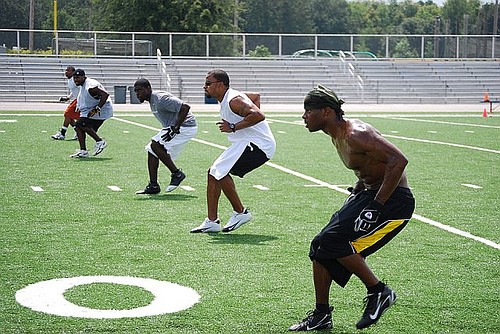
Taping Injuries
We have all seen the players / athletes running around wearing multi coloured strappings and tape… So is there any benefit to it? In this blog we will take a closer look!
Rock Tape

RockTape is a special kind of tape known as kinesiology tape. First used by acupuncturists and chiropractors in Japan, today kinesiology tape is used by practitioners throughout the world to treat injuries and improve sports performance. While the use of kinesiology tape is often associated with athletes such as Michelle Wie, Adrian Peterson and Jason Khalipa, medical professionals have been using it to alleviate a wide variety of ailments, not just sports injuries. RockTape is made from 97% cotton and 3% nylon. The adhesive is a hypo-allergenic, acrylic-based and contains no latex.
How does RockTape supposedly work?!
The concept of RockTape is based on the following.
1. RockTape turns down the volume on pain
More specifically, it runs interference on pain. Ever whack your shin and rub it, and suddenly realize you feel better? RockTape on the skin can interfere with painful signals which are directed to the brain.
When the signals arriving to the brain are altered, it does not produce the sensation of pain. When kinesiology tape is properly applied, many of our customers call it “magic” or think that it fixed their injury instantly. In fact, it helps to change how your body interprets pain, turning down the pain “volume” that your body hears.
2. Decompresses an area of swelling and inflammation
When RockTape is applied to the skin, it has a microscopic lifting effect underneath the skin and between the many layers. This allows the by-products created by inflammation to be removed more quickly.
3. It delays fatigue
Research has shown that RockTape on skin can attenuate muscle fatigue. In rehab, this is very important, not only for the parts of your body that are currently hurting, but also for the surrounding areas as they help to pick up the slack for muscles that are currently not working well.
4. It normalizes muscle tone
When someone is injured, fatigued, sick, or inflamed, the symphony of muscle action that normally takes place with great accuracy often falls out of tune. This can happen all over the body. For instance, research has shown that people who sprain their ankle tend to have altered activity of their hip muscle as a result. RockTape helps bring dormant muscle back to life and help calm down the overactive muscles. It helps your body coordinate movement as if it weren’t hurt, hence allowing it to heal properly.
5. It distributes physical stress
Unlike conventional taping, which prevents movement – RockTape allows full movement of a taped area. Through elastic properties and quick recoil, RockTape can help distribute forces to other nearby areas through the fascia, ligaments, and even bones.
There are positives and negatives to using RockTape, at Physio Tullamore we tend to use it for postural problems to provide fatigued muscles an opportunity to relax and recover. We recommend this as a temporary solution until the patient develops better muscle strength. Have a watch of the brief video below:
So why is there Rigid Taping for Ankle Sprains?
Ankle bracing and taping are used for the prevention of ankle injuries or during the post rehabilitation phase of ankle injury, especially in athletes with a past history of ankle sprains. The main difference between rigid sports tape and RockTape is that the rigid tape provides more stability to a joint. Studies examining the effectiveness of external ankle stabilization have had conflicting results. Some reports show no change in injury rates, but most have found at least some decrease in inversion sprains. Two studies involving high school basketball and football players showed that the use of lace-up ankle braces (vs unbraced controls) reduced the incidence of acute ankle injuries but did not reduce the severity of these injuries (McGuine et al, 2011).
The mechanism for this protection is still somewhat unclear. It seems logical that external devices should increase the structural stability of the ankle (ie, “stiffen the ankle joint”) and make the ankle less susceptible to inversion. Although this is true to some extent, at least one classic study has shown that regular taping can lose most of its supportive effect after only short periods of exercise (McGuine et al, 2012)
How, then, does taping or bracing decrease the incidence and severity of sprains? The answer most likely lies in a study by Robbins and Waked, which found that taped participants had improved proprioception both before and after exercise compared with untapped controls (Robbins and Waked, 1998). The authors theorized that the traction and/or pressure imparted to the skin of the foot and ankle via taping or bracing provided improved sensory input and thus improved proprioception, resulting in fewer ankle sprains (Robbins and Waked, 1998). Below is a simple video that shows how a sprained ankle can be taped when returning to sport. This method can also be used as a preventative measure:
References:
McGuine TA, Brooks A, Hetzel S. The effect of lace-up ankle braces on injury rates in high school basketball players. Am J Sports Med. 2011 Sep. 39(9):1840-8. [Medline]. [Full Text].
McGuine TA, Hetzel S, Wilson J, Brooks A. The effect of lace-up ankle braces on injury rates in high school football players. Am J Sports Med. 2012 Jan. 40(1):49-57. [Medline].
Rarick GL, Bigley G, Karst R, Malina RM. The measurable support of the ankle joint by conventional methods of taping. J Bone Joint Surg Am. 1962 Sep. 44-A:1183-90. [Medline].
Robbins S, Waked E. Factors associated with ankle injuries. Preventive measures. Sports Med. 1998 Jan. 25(1):63-72. [Medline].


.jpg)